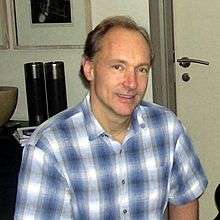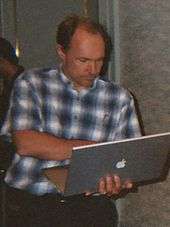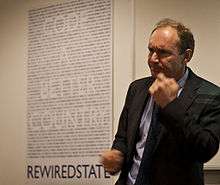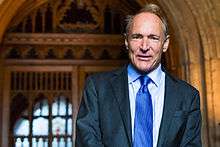Tim Berners-Lee
| Sir Tim Berners-Lee | |
|---|---|
|
Berners-Lee in 2014. | |
| Born |
Timothy John Berners-Lee 8 June 1955[1] London, England |
| Institutions | |
| Alma mater | University of Oxford (BA) |
| Notable awards | |
| Spouse |
|
|
Website www | |
Sir Timothy John Berners-Lee OM KBE FRS FREng FRSA FBCS (born 8 June 1955),[1] also known as TimBL, is an English computer scientist, best known as the inventor of the World Wide Web. He made a proposal for an information management system in March 1989,[3] and he implemented the first successful communication between a Hypertext Transfer Protocol (HTTP) client and server via the Internet sometime around mid-November of that same year.[4][5][6][7][8]
Berners-Lee is the director of the World Wide Web Consortium (W3C), which oversees the Web's continued development. He is also the founder of the World Wide Web Foundation, and is a senior researcher and holder of the Founders Chair at the MIT Computer Science and Artificial Intelligence Laboratory (CSAIL).[9] He is a director of the Web Science Research Initiative (WSRI),[10] and a member of the advisory board of the MIT Center for Collective Intelligence.[11][12] In 2011 he was named as a member the Board of Trustees of the Ford Foundation.[13]
In 2004, Berners-Lee was knighted by Queen Elizabeth II for his pioneering work.[14][15] In April 2009, he was elected a foreign associate of the United States National Academy of Sciences.[16][17] He was honoured as the "Inventor of the World Wide Web" during the 2012 Summer Olympics opening ceremony, in which he appeared in person, working with a vintage NeXT Computer at the London Olympic Stadium.[18] He tweeted "This is for everyone",[19] which instantly was spelled out in LCD lights attached to the chairs of the 80,000 people in the audience.[18]
Early life and education
Berners-Lee was born in London, England,[20] one of four children born to Mary Lee Woods and Conway Berners-Lee. His parents worked on the first commercially-built computer, the Ferranti Mark 1. He attended Sheen Mount Primary School, and then went on to attend south west London's Emanuel School from 1969 to 1973, at the time a Direct Grant grammar school, which became an independent school in 1975.[1][14] A keen trainspotter as a child, he learnt about electronics from tinkering with a model railway.[21] He studied at The Queen's College, Oxford[1] from 1973 to 1976, where he received a first-class degree Bachelor of Arts degree in physics.[20]
Career

After graduation, Berners-Lee worked as an engineer at the telecommunications company Plessey in Poole, Dorset.[20] In 1978, he joined D. G. Nash in Ferndown, Dorset, where he helped create type-setting software for printers.[20]
Berners-Lee worked as an independent contractor at CERN from June to December 1980. While there, he proposed a project based on the concept of hypertext, to facilitate sharing and updating information among researchers.[22] To demonstrate, he built a prototype system named ENQUIRE.[23]
After leaving CERN in late 1980, he went to work at John Poole's Image Computer Systems, Ltd, in Bournemouth, Dorset.[24] He ran the company's technical side for three years.[25] The project he worked on was a "real-time remote procedure call" which gave him experience in computer networking.[24] In 1984, he returned to CERN as a fellow.[23]
In 1989, CERN was the largest Internet node in Europe, and Berners-Lee saw an opportunity to join hypertext with the Internet:
"I just had to take the hypertext idea and connect it to the Transmission Control Protocol and domain name system ideas and—ta-da!—the World Wide Web[26] ... Creating the web was really an act of desperation, because the situation without it was very difficult when I was working at CERN later. Most of the technology involved in the web, like the hypertext, like the Internet, multifont text objects, had all been designed already. I just had to put them together. It was a step of generalising, going to a higher level of abstraction, thinking about all the documentation systems out there as being possibly part of a larger imaginary documentation system."[27]
Berners-Lee wrote his proposal in March 1989 and, in 1990, redistributed it. It was then accepted by his manager, Mike Sendall.[28] He used similar ideas to those underlying the ENQUIRE system to create the World Wide Web, for which he designed and built the first Web browser. His software also functioned as an editor (called WorldWideWeb, running on the NeXTSTEP operating system), and the first Web server, CERN HTTPd (short for Hypertext Transfer Protocol daemon).
"Mike Sendall buys a NeXT cube for evaluation, and gives it to Tim [Berners-Lee]. Tim's prototype implementation on NeXTStep is made in the space of a few months, thanks to the qualities of the NeXTStep software development system. This prototype offers WYSIWYG browsing/authoring! Current Web browsers used in "surfing the Internet" are mere passive windows, depriving the user of the possibility to contribute. During some sessions in the CERN cafeteria, Tim and I try to find a catching name for the system. I was determined that the name should not yet again be taken from Greek mythology..... Tim proposes "World-Wide Web". I like this very much, except that it is difficult to pronounce in French..." by Robert Cailliau, 2 November 1995.[29]

The first website built was at CERN within the border of France,[30] and was first put online on 6 August 1991:
Info.cern.ch was the address of the world's first-ever web site and web server, running on a NeXT computer at CERN. The first web page address was http://info.cern.ch/hypertext/WWW/TheProject.html, which centred on information regarding the WWW project. Visitors could learn more about hypertext, technical details for creating their own webpage, and even an explanation on how to search the Web for information. There are no screenshots of this original page and, in any case, changes were made daily to the information available on the page as the WWW project developed. You may find a later copy (1992) on the World Wide Web Consortium website.[31]
It provided an explanation of what the World Wide Web was, and how one could use a browser and set up a web server.[32][33][34][35]
In 1994, Berners-Lee founded the W3C at the Massachusetts Institute of Technology. It comprised various companies that were willing to create standards and recommendations to improve the quality of the Web. Berners-Lee made his idea available freely, with no patent and no royalties due. The World Wide Web Consortium decided that its standards should be based on royalty-free technology, so that they could easily be adopted by anyone.[36]
In 2001, Berners-Lee became a patron of the East Dorset Heritage Trust, having previously lived in Colehill in Wimborne, East Dorset.[37]
In December 2004, he accepted a chair in Computer Science at the School of Electronics and Computer Science, University of Southampton, Hampshire, to work on the Semantic Web.[38][39]
In a Times article in October 2009, Berners-Lee admitted that the initial pair of slashes ("//") in a web address were actually "unnecessary". He told the newspaper that he could easily have designed web addresses not to have the slashes. "There you go, it seemed like a good idea at the time," he said in his lighthearted apology.[40]
Current work

In June 2009 then British Prime Minister Gordon Brown announced Berners-Lee would work with the UK Government to help make data more open and accessible on the Web, building on the work of the Power of Information Task Force.[41] Berners-Lee and Professor Nigel Shadbolt are the two key figures behind data.gov.uk, a UK Government project to open up almost all data acquired for official purposes for free re-use. Commenting on the opening up of Ordnance Survey data in April 2010 Berners-Lee said that: "The changes signal a wider cultural change in Government based on an assumption that information should be in the public domain unless there is a good reason not to—not the other way around." He went on to say "Greater openness, accountability and transparency in Government will give people greater choice and make it easier for individuals to get more directly involved in issues that matter to them."[42]
In November 2009, Berners-Lee launched the World Wide Web Foundation in order to "Advance the Web to empower humanity by launching transformative programs that build local capacity to leverage the Web as a medium for positive change."[43]
Berners-Lee is one of the pioneer voices in favour of Net Neutrality,[44] and has expressed the view that ISPs should supply "connectivity with no strings attached," and should neither control nor monitor customers' browsing activities without their expressed consent.[45][46] He advocates the idea that net neutrality is a kind of human network right: "Threats to the Internet, such as companies or governments that interfere with or snoop on Internet traffic, compromise basic human network rights."[47]
Berners-Lee joined the board of advisors of start-up State.com, based in London.[48]
As of May 2012, Berners-Lee is President of the Open Data Institute.[49]

The Alliance for Affordable Internet (A4AI) was launched in October 2013 and Berners-Lee is leading the coalition of public and private organisations that includes Google, Facebook, Intel and Microsoft. The A4AI seeks to make Internet access more affordable so that access is broadened in the developing world, where only 31% of people are online. Berners-Lee will help to decrease internet access prices so that they fall below the UN Broadband Commission's worldwide target of 5% of monthly income.[50]
Awards and honours

Berners-Lee has received many awards and honours.
Berners-lee was knighted in 2004 when he was promoted to Knight Commander of the Order of the British Empire (KBE) in the New Year Honours "for services to the global development of the Internet", and was formally invested on 16 July 2004.[14][15] On 13 June 2007, he received the Order of Merit, becoming one of only 24 living members entitled to hold the honour, and to use the post-nominals 'O.M.' after their name.[51] (The Order of Merit is within the personal bestowal of The Queen, and does not require recommendation by ministers or the Prime Minister). He was elected a Fellow of the Royal Society (FRS) in 2001.[2]|
Personal life
In 2014 Berners-Lee and Rosemary Leith were married at St James's Palace in London.[52] Berners-Lee was previously married to Nancy Carlson in 1990 and the marriage ended in divorce. Rosemary Leith is Director of the World Wide Web Foundation and Fellow at Harvard University's Berkman Center. She was previously World Economic Forum Global Agenda Council Chair of the Future of Internet Security [53] and is on the board of YouGov.[54]
Religious views
Berners-Lee was raised as an Anglican, but in his youth, he turned away from religion, and in his adulthood he became a Unitarian Universalist (UU).[55] He has stated: "Like many people, I had a religious upbringing which I rejected as a teenager... Like many people, I came back to religion when we had children".[56] He and his wife wanted to teach spirituality to his children, and after hearing a Unitarian minister and visiting the UU Church, they opted for it.[57] He is an active member of that Church,[58] to which he adheres because he perceives it as a tolerant and liberal belief. He has also recognized the value of other faiths, stating: "I believe that much of the philosophy of life associated with many religions is much more sound than the dogma which comes along with it. So I do respect them."[56]
See also
References
- 1 2 3 4 BERNERS-LEE, Sir Timothy (John). Who's Who 2015 (online Oxford University Press ed.). A & C Black, an imprint of Bloomsbury Publishing plc. (subscription required)
- 1 2 "Fellowship of the Royal Society 1660-2015". London: Royal Society. Archived from the original on 2015-07-15.
- ↑ "info.cern.ch – Tim Berners-Lee's proposal". Info.cern.ch. Retrieved 21 December 2011.
- ↑ Tim Berners Lee's own reference. The exact date is unknown.
- ↑ Berners-Lee, Tim; Mark Fischetti (1999). Weaving the Web: The Original Design and Ultimate Destiny of the World Wide Web by its inventor. Britain: Orion Business. ISBN 0-7528-2090-7.
- ↑ Berners-Lee, T. (2010). "Long Live the Web". Scientific American 303 (6): 80–85. doi:10.1038/scientificamerican1210-80. PMID 21141362.
- ↑ Shadbolt, N.; Berners-Lee, T. (2008). "Web science emerges". Scientific American 299 (4): 76–81. doi:10.1038/scientificamerican1008-76. PMID 18847088.
- ↑ Berners-Lee, T.; Hall, W.; Hendler, J.; Shadbolt, N.; Weitzner, D. (2006). "Computer Science: Enhanced: Creating a Science of the Web". Science 313 (5788): 769–771. doi:10.1126/science.1126902. PMID 16902115.
- ↑ "Draper Prize". Massachusetts Institute of Technology. Retrieved 25 May 2008.
- ↑ "People". The Web Science Research Initiative. Archived from the original on 28 June 2008. Retrieved 17 January 2011.
- ↑ "MIT Center for Collective Intelligence (homepage)". Cci.mit.edu. Retrieved 15 August 2010.
- ↑ "MIT Center for Collective Intelligence (people)". Cci.mit.edu. Retrieved 15 August 2010.
- ↑ "Tim Berners-Lee and Martin Eakes Join Ford Foundation Board", Ford Foundation, 29 September 2011.
- 1 2 3 "Web's inventor gets a knighthood". BBC News. 31 December 2003. Retrieved 10 November 2015.
- 1 2 "Creator of the web turns knight". BBC News. 16 July 2004. Retrieved 10 November 2015.
- ↑ "Timothy Berners-Lee Elected to National Academy of Sciences". Dr. Dobb's Journal. Retrieved 9 June 2009.
- ↑ "72 New Members Chosen By Academy" (Press release). United States National Academy of Sciences. 28 April 2009. Retrieved 17 January 2011.
- 1 2 Friar, Karen (28 July 2012). "Sir Tim Berners-Lee stars in Olympics opening ceremony". ZDNet. Retrieved 28 July 2012.
- 1 2 Berners-Lee, Tim (27 July 2012). "This is for everyone". Twitter. Retrieved 28 July 2012.
- 1 2 3 4 "Berners-Lee Longer Biography". World Wide Web Consortium. Retrieved 18 January 2011.
- ↑ "Lunch with the FT: Tim Berners-Lee". Financial Times.
- ↑ "Berners-Lee's original proposal to CERN". World Wide Web Consortium. March 1989. Retrieved 25 May 2008.
- 1 2 Stewart, Bill. "Tim Berners-Lee, Robert Cailliau, and the World Wide Web". Retrieved 22 July 2010.
- 1 2 Tim Berners-Lee. "Frequently asked questions". World Wide Web Consortium. Retrieved 22 July 2010.
- ↑ Grossman, Wendy (15 July 1996). "All you never knew about the Net ...". The Independent.
- ↑ Tim Berners-Lee. "Answers for Young People". World Wide Web Consortium. Retrieved 25 May 2008.
- ↑ "Biography and Video Interview of Timothy Berners-Lee at Academy of Achievement". Achievement.org. Retrieved 21 December 2011.
- ↑ "Ten Years Public Domain for the Original Web Software". CERN. Retrieved 21 July 2010.
- ↑ Roads and Crossroads of Internet History Chapter 4: Birth of the Web
- ↑ "Tim Berners-Lee. Confirming The Exact Location Where the Web Was Invented".
- ↑ -CERN
- ↑ "Welcome to info.cern.ch, the website of the world's first-ever web server". CERN. Retrieved 25 May 2008.
- ↑ "World Wide Web—Archive of world's first website". World Wide Web Consortium. Retrieved 25 May 2008.
- ↑ "World Wide Web—First mentioned on USENET". Google. 6 August 1991. Retrieved 25 May 2008.
- ↑ "The original post to alt.hypertalk describing the WorldWideWeb Project". Google Groups. Google. 9 August 1991. Retrieved 25 May 2008.
- ↑ "Patent Policy—5 February 2004". World Wide Web Consortium. 5 February 2004. Retrieved 25 May 2008.
- ↑ John W. Klooster (2009) Icons of invention: the makers of the modern world from Gutenberg to Gates p.611. ABC-CLIO, 2009
- ↑ Berners-Lee, T.; Hendler, J.; Lassila, O. (2001). "The Semantic Web". Scientific American 2841 (5): 34. doi:10.1038/scientificamerican0501-34.
- ↑ "Tim Berners-Lee, World Wide Web inventor, to join ECS". World Wide Web Consortium. 2 December 2004. Retrieved 25 May 2008.
- ↑ "Berners-Lee 'sorry' for slashes". BBC. 14 October 2009. Retrieved 14 October 2009.
- ↑ "Tim Berners-Lee". World Wide Web Consortium. 10 June 2009. Retrieved 10 July 2009.
- ↑ "Ordnance Survey offers free data access". BBC News. 1 April 2010. Retrieved 3 April 2009.
- ↑ FAQ—World Wide Web Foundation Retrieved 18 January 2011
- ↑ Ghosh, Pallab (15 September 2008). "Web creator rejects net tracking". BBC. Retrieved 15 September 2008.
Warning sounded on web's future.
- ↑ Cellan-Jones, Rory (March 2008). "Web creator rejects net tracking". BBC. Retrieved 25 May 2008.
Sir Tim rejects net tracking like Phorm.
- ↑ Adams, Stephen (March 2008). "Web inventor's warning on spy software". The Daily Telegraph (London). Retrieved 25 May 2008.
Sir Tim rejects net tracking like Phorm.
- ↑ Berners, Tim (4 May 2011). "Tim Berners-Lee, Long Live the Web: A Call for Continued Open Standards and Neutrality, Scientific American Magazine, December 2010". Scientific American. Retrieved 21 December 2011.
- ↑ "State.com/about/people". Retrieved 9 September 2013.
- ↑ Computing, Government (23 May 2012). "Government commits £10m to Open Data Institute". The Guardian.
- ↑ Samuel Gibbs (7 October 2013). "Sir Tim Berners-Lee and Google lead coalition for cheaper internet". The Guardian. Retrieved 8 October 2013.
- ↑ "Web inventor gets Queen's honour". BBC. 13 June 2007. Retrieved 25 May 2008.
- ↑ "“Ms Rosemary Leith and Sir Tim Berners-Lee are delighted to announce that they celebrated their marriage on 20 June 2014...." World Wide Web Foundation.
- ↑ Rosemary Leith biography, World Economic Forum.
- ↑ "YouGov strengthens its board", Interactive Investor, 21 January 2015.
- ↑ "Faces of the week". Archived from the original on 26 September 2003.
- 1 2 Bernees-Lee, Tim. 1998. The World Wide Web and the "Web of Life".
- ↑ Stephanie Sammartino McPherson. 2009. "Tim Berners-Lee: Inventor of the World Wide Web. Twenty-First Century Books. p. 83: "A Church Like The Web"
- ↑ Eden, Richard. 2011. Internet pioneer Sir Tim Berners-Lee casts a web of intrigue with his love life. The Telegraph
Further reading
- Tim Berners-Lee and the Development of the World Wide Web (Unlocking the Secrets of Science) (Mitchell Lane Publishers, 2001), ISBN 1-58415-096-3
- Tim Berners-Lee: Inventor of the World Wide Web (Ferguson's Career Biographies), Melissa Stewart (Ferguson Publishing Company, 2001), ISBN 0-89434-367-X children's biography
- How the Web was Born: The Story of the World Wide Web, Robert Cailliau, James Gillies, R. Cailliau (Oxford University Press, 2000), ISBN 0-19-286207-3
- "Man Who Invented the World Wide Web Gives it New Definition", Compute Magazine, 11 February 2011
- BBC2 Newsnight – Transcript of video interview of Berners-Lee on the read/write Web
- Technology Review interview
External links
| Wikimedia Commons has media related to Tim Berners-Lee. |
| Wikiquote has quotations related to: Tim Berners-Lee |
- Tim Berners-Lee on Twitter
- Tim Berners-Lee at TED
- Tim Berners-Lee at the Internet Movie Database
- Works by or about Tim Berners-Lee in libraries (WorldCat catalog)
- Tim Berners-Lee on the W3C site
- First World Wide Web page
- Interview with Tim Berners Lee
- Tim Berners-Lee: "The next Web of open, linked data" - presentation on why he invented the internet (2009), Ted Talks.
- Appearances on C-SPAN
| Preceded by First recipient |
Millennium Technology Prize winner 2004 (for the World Wide Web) |
Succeeded by Shuji Nakamura |
| ||||||||||||||||||||||||||||||||||||||||||||||||||||||||||||||
|
